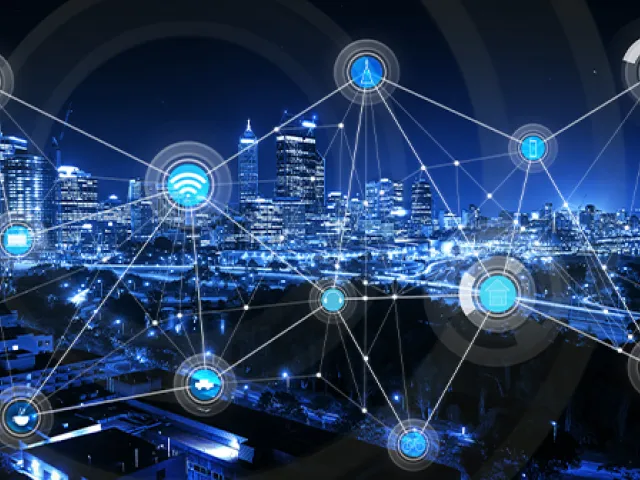Table of contents

Supply chain digitalization is about more than just the digital exchange of data. It is about building scalable digital bridges of visibility, collaboration, and orchestration with all of your trading partner networks and fueling real-time, strategic decision-making. Watch this video and you will learn:
- Why digitalizing your supply chain through intelligent orchestration will create a strategic competitive advantage for your company.
- How to leverage “moments of business change” to build your digital orchestration foundation.
- How companies can leverage the data and intelligence created by your digital supply chain network to fuel AI initiatives.
You'll also learn the strategic questions executive leaders should be asking right now to begin their supply chain orchestration journey. Watch now!
Featured Speakers:
Alessandro De Luca
Group CIO and Head of IT
Merck Group
Marco Odoardi Global
Head of Integrated Operations Planning
Merck Group
TRANSCRIPT
TRANSCRIPT
Alessandro de Luca: We are going to talk about what we have been trying to do since several years, what we are still planning to do for the next year to come. That is as simple as infusing some form of intelligence -- that could be human intelligence, could be technology intelligence, could be process intelligence -- into our supply chain.
Obviously, like Shabbir mentioned, like he put it, we want to achieve better serving for our customer and patient.
The presentation is about our journey, our learnings, what we've done well, what we have done less well, and then there is a deep dive of what we are doing exactly now with a part of this program that Marco will go into the detail that is called IOP, and he will explain more detail than me.
A few words of introduction. I'm Alessandro de Luca. I'm the technologist of the two of us. I've been working 20 years in Procter & Gamble, fast-moving consumer good, and more or less 15 years in pharma. I'm the group CIO. Marco.
Marco Odoardi: I'm Marco Odoardi. Since 10 years in Merck, led several transformation. Now leading the transformation on introducing the new technology on the supply chain and more to come after, and infusing a bit of strategy into it. I was a former consultant from McKinsey.
Alessandro: Very good. Thanks. Let's go through the topics. Like I said, the agenda is simple. I'll explain the macro vision, where we want to go, how we want to go, where we are today. We deep dive on the phase of today with IOP, integrated operation planning.
We explain what's changing and what's the value added of that piece. Then we want to close with some remarks, out of our learnings of several years of our journey.
One marketing slide about Merck. Merck Group is a German-based company. We have 70 billion market capitalization. We are fundamentally operating worldwide in every single country, 63,000 employees. It's a publicly-listed company, privately-owned, so it's 70/30.
What we claim ourselves as a source of competitive advantage, but I think is a source of competitive advantage in every industry, is that we are a science and technology company. That means that the [inaudible] convergence between science, so scientists, and technology, it's what makes industry progress.
That it's impossible to separate the two elements in today's world, like it's impossible to separate this presentation between what I'm going to talk about technologies and what Marco is going to talk about operation. It's the combination of the two elements that will make progression in every single company.
When and where we started? Quite some years ago, when I was in fast-moving consumer good -- and then I tried to trace back when it was. It was '98, '99, so I can claim last century. Last century. When you talk about the last century, you look like a dinosaur on stage. I told it to my son that I was talking about last century, he told me, "What's this?"
Anyways. At that point in time, there was a product supply officer in Procter & Gamble called Keith Harrison. He started what he was saying as his vision, let's take the real demand. Whatever is the real demand from our customer, let's focus on this with a smoothless information flow and product flow in order to better supply our customer.
Let's forget the forecast. Let's really moved to produce to demand. Of course, these were, like I said, the '98. The technology was not there. People were not understanding the value of data that Shabbir mentioned it. The power of processes, planning system was not there, but the concept was already there.
How do we leverage real-time information, how much we could gather at that time in order to produce to demand to gain competitive edge? That's where the journey started. That's where I started the journey. Then, like I said, I spent 20 years there. I moved to Merck, and that's where the journey started in Merck.
The journey started in Merck much earlier. For the people of Merck here in healthcare -- by the way, we are talking about the Merck Healthcare division -- the vision started more or less seven, eight years ago when we start to nail down our vision.
What would be our vision to go? Our mission at that time -- and still remains valid today with few changes, mainly driven for process technology -- it's very simple. Demand should be automatically predicted without new human intervention.
One of the measures that we put in place is that the number of intervention that the planner should do. We try to limit every single intervention from the demand standpoint.
How to do it? Obviously, capture advanced analytic -- at that point, it was called advanced analytic. Today, we would call AI-based model -- in a combination of sourcing the data. That was the clear differentiation, sourcing the data from internal and external.
I think Shabbir said it extremely right. The competitive advantage is data feed any type of system. Of course, the more the system gets fed from data, the more it's spun to the network, the higher is the capability of prediction. That's the element of the demand.
The element of supply is what we call end-to-end supply management, or if you want today, we would call it network-to-network supply management.
It's to having an online synchronization in a control tower fashion across all the different element of supply chain across our manufacturing plant -- we have more than 150 manufacturing plant around the world across the three sectors -- and synchronize this in such a way that would have an AI-based business information for the total network.
Marco will deep dive in what we are doing there for what concern the networking of the plants, and how do we want to leverage this piece of information? That's the vision. Obviously, as we all know, the vision looks beautiful on PowerPoint. On PowerPoint, everything looks amazing, fantastic, we love it, and so on and so forth.
The journey is being quite difficult with up and down. Let's see where we started and where we are moving to. We started, like I said, six, seven years ago in the Merck healthcare sector, where all the information was more or less scattered in different silos. We had different sources of information. Capabilities of technology was not yet there.
At that point, we put in place a program that was called let's move towards self-driving supply chain. Very catchy name, very sexy program. In reality, it was let's leverage the advantage of an advanced planning system in order to make sure that we could really plan better our supply chain. That worked quite well.
We established an advanced planning system. We progressed significant in that area. I'll show you also what we obtained in terms of business impact, but that was not sufficient, obviously. An advanced planning system enabled to step change your supply chain planning capabilities, but doesn't give you the overall supply chain performance in a good way.
This is where we move to the next step. The next step was natural evolution that I'm sure a lot of you have done it from S&OP to IBP, integrated business planning. The concept of one number in fast-moving consumer good in P&G was developed years ago.
In pharma, at least in Merck at that time was still new. Still were a lot of debates, "Is my number from sales? Is my number from finance or supply chain right?" and whatever. We move on a process-based one number, with one source of truth and one integrated plan that will develop the moving forward. That also helped us quite a lot.
Then we recognize, OK, that now we have a planning system working, we have everything synchronized, we have one number in terms of processes, what else could we do? That's where we started working several years ago, but now we formalizing a program with IOP, we started working on the upstream element of the supply chain.
They were all supply part in terms of all our manufacturing plant. That we could get more real-time synchronized data across all the manufacturing plants, CMO, and so on and so far. This is where we are today.
The future, it's really what Shabbir envisioned in a certain way as network, what technology will give it as. It's also a fact of collaborating across the company in this network-to-network supply network for the future. This is really what we want to do.
That's why when Shabbir, I remember it was five years ago, six years ago, he talked me about this idea, I said, "That's fantastic." This is exactly where we have to go. This is exactly where the whole industry have to move, and this is exactly where the collaboration, the technology and the process, merged together, will make the difference for all of us.
Now we have the technology, we have to go there also as a company. Where we are today in this journey? We completed the first two steps, like I said it before, and we are now working in detail in the IOP program that we're going to explain to you in a moment.
The second question that I always get is that this is great, but what is the business value out of all this? Melie, my CEO, keeps repeating that every single digital should have a business value associated to it, and I guess that's the same for all of us.
We all know digital is great, AI is an hype, but at the end, it's all about creating value for the business and serving better our patient.
What we achieve in Merck Healthcare across the different phases of our program. The first phase, obviously, implementing an advanced planning system was all about eliminating loss in the overall planning, serving better the customer.
There, we had the dramatic improve in terms of service. We moved from the 96 percent OTIF more or less in Merck Healthcare towards 99.9 sustainably. It's been sustained in the last three, four, five years, even across COVID. Very good improvement for the service standpoint.
The second element, one number, the IBP point, it's all about inventory. Obviously, having one number, having everybody's sales, finance, supply chain working against an integrated plan enables to eliminate waste. What is the waste in supply chain? It's inventory. That's where we get a significant reduction of our inventory.
Now we are embarking in the part of IOP because believing in integrating all our operation planning at plant level and above will help us to reduce cost.
The last part of our journey will be when we move to this network-to-network is the value creation in terms of sales, in terms of being able to capture every single opportunity for selling in a better way, supplying perfectly smoothless our supply chain.
Having said that, now we'll go through the IOP part.
Marco: Thanks, Alessandro.
Alessandro: I'll give you over to Marc.
Marco: Let me give you real-life from the shop floor feeling of what it means to be at step three. At step three means we went through the various step one, step two, we have the data, it integrated the supply chain.
Unfortunately, we live in a world that is really volatile, uncertain, complex, ambiguous. We need to take a decision on supply chain very quickly.
You know what is the average between a moment of disruption applying in the supply chain and the moment in which we are able to take a decision? Minimum is seven days, maximum is months. Why? Because we are struggling on predictivity. We are struggling on having transparency on what might happen in the next weeks, in the next month, in the next quarter.
With step three, we want to go there. We want to try to give instruments to our decision maker to really read the crystal ball, becoming predictive, and saying, "I expect this to happen. Let me take advantage of it, and let me take a decision before."
Let me be very clear. Is it something that only Merck fail or is an industry trend? It's an industry trend. 79 percent of the biggest supply chain organization in the world are planning, in the next four years, to introduce predictivity, better technology, better data to understand what is going to happen and take decisions in advance.
50 percent of them are even thinking to change their internal decision-making process and responsibility. They are thinking to change the way people interact with technology to take advantage of it. Even more importantly, every one of them believes that this is having P&L impact.
Across the Fortune 500 company has been done a statistical analysis of what is the P&L impact on being able to be predictive. In average, it means a P&L €250 million per year better for the ones that are able to be predictive. It's pretty intuitive. You are able to take decision in advance, you are having P&L impact.
Now, we translated for ourselves what it means to be predictive. We need to be extremely clear. We need to have a vision, as Alessandro said. For us, this means get to a stage in which our decision-making on supply chain is able to be synchronized, data-driven, real-time, forward-looking, cross-function.
I know. This might sound like a bunch of buzzword, [laughs] but behind each of them, there is a mini-revolution. Synchronized means that every function in a supply chain has the same set of data in the same scenario, in the same moment.
For many of you that are leading supply chain, you know how difficult it is to have different stakeholders having the same picture at the same moment, data-driven, really using the data to take decision.
Real time or quasi real time means not waiting weeks before understanding, what is the situation? Forward-looking, very interesting, seems another buzzword, but basically means having scenario. Being able to understand what is going to happen in 6, 12, 18 months on your supply chain.
Cross-functional. Cross-functional means everyone in the organization taking a decision on the supply chain is able to understand the implication for the others.
Someone in manufacturing understanding the implication for quality. Someone in controlling understanding the implication for CO2 emission. Transformational in terms of even the way we act internally in a supply chain.
Looks like science fiction, but actually, this is a bit the image that I'm using sometime to explain what we are trying to do. You might have seen the movie "Minority Report," with Tom Cruise getting a ball, being a policeman, a ball with a prediction of what is going to happen, a crime, and trying to act before to avoid the crime.
We're trying to do the same on supply chain. Getting the ball, the prediction, and say, "This is going to happen. Let me do something before."
I wanted to give you a bit of a flavor of what it means for an executive. Cannot give a demo of the platform we have, but very quickly built something quick and dirty for you just to give you a flavor of what is that.
Imagine, close your eyes maybe, or imagine to have something that is not a report, it's not a dashboard -- dashboards are over -- that is predicting how your supply chain will evolve in the future. The timescale is not the past, it's the future.
Our prediction. Predictions for service level, for cost level, for inventory level, for quality, for CO2 emission, utilization of your supply chain.
Through this, you can say, "OK. I see that in 18 months, I will have a very bad service level. I will have a problem in one year and a half. Can I do something? Can I intervene like Tom Cruise before, and how do I do it? Can technology help me to play with the parameters like a Rubik Cube?"
You might remember I'm 50, so I remember I was playing with the Rubik Cube, with the parameters to find the perfect match of the parameters in a way that actually, my supply chain will work better. Can I do it? If I find the right parameters, how will my performance evolve? I apply those parameters, boom, magically, wow.
Now I have a scenario in which I'm able to catch my commitment to the CEO, to the patient, to the market. One of the examples I'm very often using is these six dimensions are almost like the six commitments that as an executive, I can give on the way I lead my supply chain. Can I simulate if I'm able to stick to my commitment?
Can I have a tool, a process, and people behaviors that are allowing for taking the decision in advance? This is IOP. We are going live with this. We want to scale up. One of the challenge is being able to integrate the full network into it. It's a challenge that many of you have. However, it's not anymore science fiction. It's becoming reality.
There are several lessons learned from this step. First, we do this for business impact, for use case. Alessandro already mentioned some of this. Quite actively, what we are targeting, several elements of business impact, I would say one is really attracting my attention, that is decision-making.
In the world we are in this moment, we cannot anymore afford to wait for weeks or days before taking a certain decision. The reactivity is over. We need to become predictive, and going back to having the possibility with a finger click to understand, what are my options in taking a decision?
Can you imagine, especially in an industry like pharma industry, what it means being able to take a decision three months in advance for pharma? It's massive.
Just for closing this, I'm receiving a lot of pressure on being quick or rolling this out. This is my classic answer to everyone. I'm sure that we can do quick, and you are overestimating the impact that we can get in the short, but I'm also sure that you are underestimating the impact on the long-term.
Are we ready as an industry to have tools, processes, system, and behaviors that are allowing to achieve this? It's a big step. It's not only technology, it's a transformation. It's a business model transformation, I would say.
Let me maybe go to the lesson learned. Should I start?
Alessandro: Yes. Start.
Marco: The first one is exactly what I said. Don't look for silver bullet technology. It's extremely difficult to achieve it, and it's extremely difficult to fit a technology without thinking to, what is the process, and the system, and the people behavior?
Change management and people is crucial. This is one of the main focuses of my daily effort and what is keeping me awake every night.
Alessandro: Perhaps I can build on this. Like I said, I'm the technologist, so I'll provide the technology. I'm the service provider there. You can imagine that explaining to the people in the organization that the dashboard that you've seen before is not the dashboard of what's happening, but is the dashboard of what will happen. Then the head of operation tell us.
This is not what is the service. They know this is what the service will be nine months from now if you act on this lever and so on. This will be what will be the cost that you have in it. It's a change in the people's mind to look forward rather than backward. That's why it's a significant step change on change people. Significant.
The second point, I echo Shabbir words. It's as simple as that. We can talk about the most beautiful GenAI in the world, Steve Jobs could come back here, we have [inaudible] money. The truth of the matter, no clean data, no value. The truth of the matter, the heroes in this history as the master data manager. The guy that fix it.
Anyways. Then the third element very much to our heart is that there are no companies in silos anymore. We already know. We already know that supply networks are becoming more and more complexity. Resilience is the key behavior of virtual supply chain.
[background music]
Alessandro: The collaboration across and beyond our single network will become the competitive advantage for the future.





